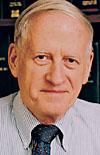Biography
Dr. Ward graduated from the University of Michigan Medical School in June 1960. He completed his training in Anatomic Pathology at University Hospital (Ann Arbor in June 1963) and completed a post-doctoral fellowship in June 1965 under the mentorship of Drs. Charles Cochrane and Hans-Miller-Eberhard at the Scripps Clinic and Research Foundation (La Jolla, California). During this time, he discovered that a fragment from C5 was chemotactic for neutrophils. During 1965-1971, he was Chief of the Immunobiology Branch at the Armed Forces Institute of Pathology (at Walter Reed Army Hospital). From 1965-1967, he was a Captain in the U.S. Army Medical Corps. He moved to the new University of Connecticut Health Center (Farmington, CT) in July, 1971 where he was Professor of Pathology and continued his work on the role of oxygen radicals in inflammatory states. In July, 1980, he became Chair of the Department of Pathology (1980-2005) at the University of Michigan Medical School where he continued his interests in the role of complement in the inflammatory response. Details of his recent research are provided in the section on Research Interests.
Research Interests
The main focus of our laboratory is the regulation of the inflammatory response. An in vivo model of acute lung injury has been developed in mice. The role of various adhesion molecules (e.g. ICAM-1, VCAM-1), cytokines (e.g. TNF), chemokines (e.g. MIP-2, CINC), anti-inflammatory interleukins (e.g. IL-10, IL-13), complement factors (e.g. C5a), endogenous protease inhibitors (e.g. TIMP-2 and SLPI) and histones are studied in this model as well as in vitro. A second area of research is sepsis. Our earlier studies have shown that sepsis developing in rodents after cecal ligation and puncture (CLP) is associated with activation of complement and generation of the anaphylatoxin, C5a, which then interacts with its receptors (C5aR1, C5aR2) present on a variety of cells, both myeloid and myeloid-derived cells. Such interactions appear to be associated with the multiorgan failure of sepsis. Currently, we have a focus on C5a being able to interact with cardiomyocytes, resulting in heart failure. Cardiac dysfunction is a major complication of sepsis, resulting in septic shock. Currently, two of my former postdoctoral fellows at the University of Jena, Germany, have initiated Phase II Clinical Trials in humans with sepsis, using a “humanized’ version of a mouse antibody that neutralizes C5a. In addition, we study some of the signaling molecules such as MAP-kinases and the transcription factor NF-kB involved in the inflammatory response. Our laboratory routinely uses some of the standard cellular and molecular biological techniques such as cloning, RT-PCR, Western and Northern blot analysis, ELISA, antibody production, bacterial and mammalian expression of proteins, transfections, etc. Currently, our group is studying the extent to which sepsis in mice causes functional and structural changes in the brain, which appears to be complement-dependent.

